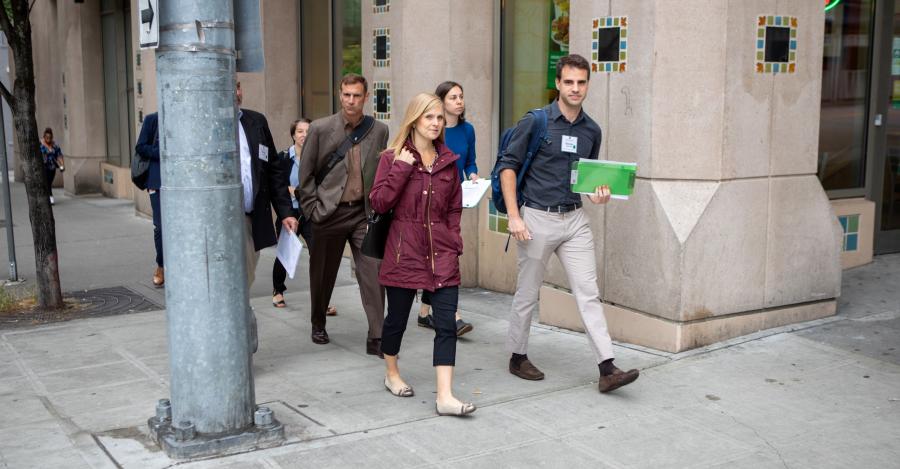
Urban Freight Lab studies how Seattle’s curbs are used
OCTOBER 15, 2019 — Curb space is an important part of the public right-of-way, providing on-street parking and loading and unloading space for personal and delivery vehicles. For commercial vehicles used for freight transportation and provision of services, a lack of adequate parking can have negative impacts that affect all users of the road.
New Urban Freight Lab study “Commercial Vehicle Parking in Downtown Seattle: Insights on the Battle for the Curb,” published in in Transportation Research Record: Journal of the Transportation Research Board, explores how, when, and by whom curb space is being used in Seattle’s densest downtown core. The study suggests “a need to revise Seattle’s existing parking policies, and a data-based foundation for doing so.”
Researchers developed and implemented a data collection method to quantify curb space usage, observing more than 1,800 on-street parking operations at five downtown Seattle locations during regular business hours. The study captures the parking behavior and patterns of commercial vehicles (delivery service, waste management, and construction vehicles) throughout the block face, as well as parking activities of all vehicles (including passenger vehicles) in commercial vehicle loading zones (CVLZs).
The study presents the following key findings:
1. Commercial vehicles park outside of CVLZs.
- On average, 40% of commercial vehicles (with delivery vehicles constituting the largest share) parked in unauthorized locations: double parked or parked in transit lanes, tow-away zones, no-parking zones, and passenger loading zones (PLZs).
2. Commercial and passenger vehicle drivers use CVLZs and PLZs fluidly.
- Passenger vehicles made up more than half (52%) of all vehicles parked in CVLZs; delivery vehicles made up just 26%.
3. Most CVLZ demand is for short-term operations, but some commercial vehicles need longer parking at the curb.
- Most vehicles parked in CVLZs for short-term operations. Across all study areas and curb uses, more than half (63%) of all commercial vehicles parked for 15 minutes or less; 78% for 30 minutes or less.
4. About one third (36%) of all commercial vehicles parked on the curb were service vehicles.
- In contrast to delivery vehicles, parking behavior of service vehicles was bifurcated: 56% parked for 30 minutes or less; 44% parked for more than 30 minutes; the remaining 27% parked for an hour or more. Because service vehicles make up such a large share of total commercial vehicles at the curb, this may have a disproportionate impact on turn rates.
5. Variation in the distribution of vehicle types and curb uses relates to the spatial distribution of the current infrastructure and land use.
High levels of unauthorized parking (double parking, in transit lanes, tow-away zones, no-parking zones, and passenger loading zones) were found in all five study areas. The most recurrent unauthorized behavior was parking in PLZs spaces. Conversely, passenger vehicles made up more than half of all vehicles parked in CVLZs.
READ MORE:
Read the research: Commercial Vehicle Parking in Downtown Seattle: Insights on the Battle for the Curb
About the Urban Freight Lab (UFL): An innovative public-private partnership housed at the Supply Chain Transportation & Logistics Center at the University of Washington, the Urban Freight Lab is a structured workgroup that brings together private industry with City transportation officials to design and test solutions around urban freight management.
About the Final 50 Feet Research Program: The Urban Freight Lab’s Final 50 Feet research program designs and tests solutions to improve delivery at the end of the supply chain—beginning at a load/unload parking space at the curb, in an alley, or in a private loading bay, and maneuvering through sidewalks, intersections, and building security, and ending with the final customer.